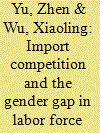|
|
|
Sort Order |
|
|
|
Items / Page
|
|
|
|
|
|
|
| Srl | Item |
| 1 |
ID:
182794


|
|
|
|
|
| Summary/Abstract |
Conventional wisdom suggests that, if a large nation reduces tariffs, the Rest of the World (RoW) as a whole should immediately experience gains from trade. However, little simulation evidence has been provided to evaluate the welfare effects of China's tariff reduction upon its WTO accession on each of its trade partners. This paper addresses the above issue under both the perfectly competitive model and the monopolistic competition framework à la Eaton and Kortum (2002) and Melitz (2003). Armed by the method of Dekle, Eaton, and Kortum (2007, 2008) to quantify the individual countries' responses to the “China (trade liberalization) shock” at equilibrium, we could check the extent to which global welfare benefit from the import tariff reduction after China's entry into the WTO. The quantitative results show that, both China and the RoW benefit from Chinese participation into the WTO, with estimated welfare gains falling in a range of [1.4697%, 3.8743%] and [0.0743%, 0.1015%], respectively. That is to say, about 58.24% of total benefits extracted from China's accession into the WTO worldwide flow to countries other than China under perfect competition; while under monopolistic competition, the whole world enjoys a 0.1571% welfare increases if firms' entry is restricted, of which 42.64% are injected into the RoW, an equivalent amount of 23.3903 billion US dollars. Since allowing for firms' entry and exit would lead to adjustments in both aggregate price indices and government tariff revenues, welfare gains of the world significantly increase (0.2474%), but these adjustments would slightly distort the welfare changes for other countries in the sense that only 36.50%, which is equivalent to 32.1008 billion US dollars, overflow to the RoW. As a result, some countries gain more, while some less.
|
|
|
|
|
|
|
|
|
|
|
|
|
|
|
|
| 2 |
ID:
182793


|
|
|
|
|
| Summary/Abstract |
Does import competition explain the gender gap in labor force participation? The distributional consequences of trade liberalization have fascinated decades of economists and policy makers. Using a difference-in-differences strategy, we find that import competition enlarges the gender gap in labor force participation in China during 1990 and 2005. The results are robust to various identification challenges, including contemporaneous confounders, treatment effect heterogeneity, and spatial correlations in standard errors. The magnitude of the gender-differential effects of import competition on labor force participation grows by age, and peaks for people aged 46–50. The household division of labor appears to explain the gender-differential effects. Import competition also leads to a relative contraction of female-intensive industries, and reduces the share of female employees in each industry.
|
|
|
|
|
|
|
|
|
|
|
|
|
|
|
|
|
|
|
|
|